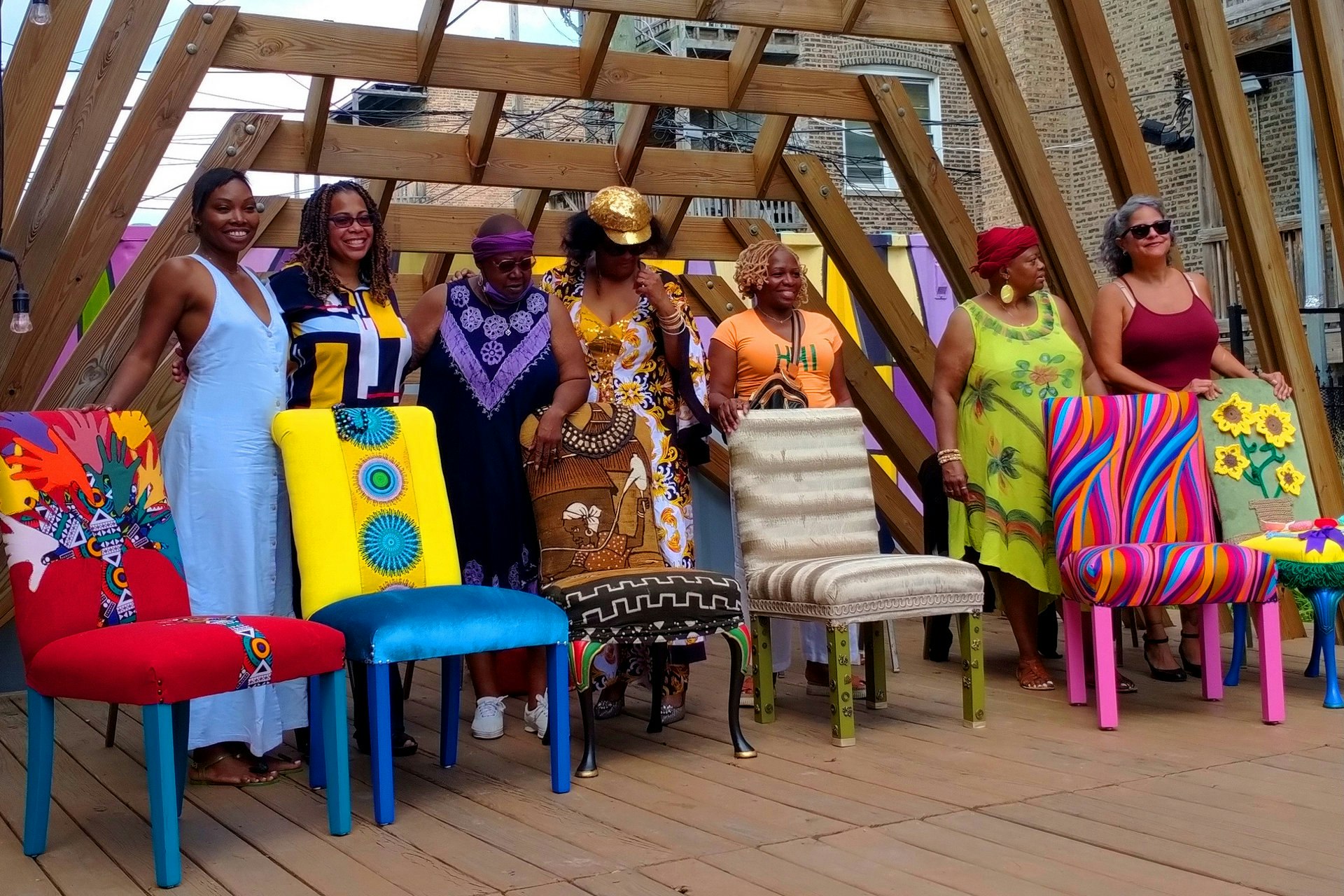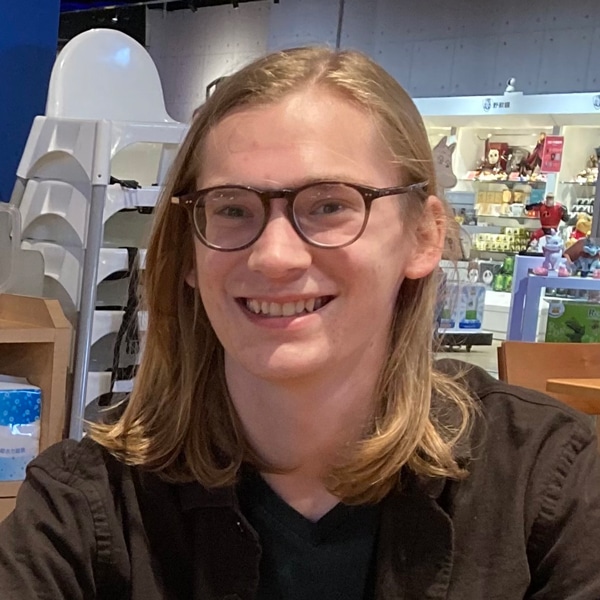Chairs as Activist Art
Throughout the history of the Goldin Institute, many Peace Fellows have used art as a way to bring communities together, reflect, and create. Jamika Smith, a 2022 Chicago Peace Fellow and the founder of Teena’s Legacy, uses a unique medium to promote these kinds of practices, teaching the art of upholstery as a tool for healing and community activism. Recently, Jamika has worked on two substantial projects, collaborating with community members from the Black and Latino community to use re-upholstery as a tool to explore their history and facilitate healing.
Chairs that Explore Black History: Blooming Out of Trauma
For Black History Month, Teena’s Legacy hosted their very first art exhibit, “Blooming Out of Trauma: The Intersection of Upholstery and Activist Art.” The exhibit was hosted at the Marshall J. Gardner Center for the Arts in Gary, Indiana from February 2 through March 8. For this exhibit, Jamika worked collaboratively with community artists to create fourteen works that trace a peoples’ history from the African Empire and slave trade, through Jim Crow and Civil rights eras, to contemporary experiences. Speaking to the collaborative nature of the exhibit, Jamika stated: “I intentionally wanted this to be a collaborative project, so I [brought in] a couple of artists from Chicago, an artist from Hammond, Indiana, and a majority of artists from Gary.”
Blooming Out of Trauma aimed to capture both the struggles and achievements of African and Black History. Speaking to her inspiration for the exhibit, Jamika said: “A lot of my chairs, especially when I do my workshops, are more about purpose driven pieces, designed with intention. This exhibit is what that is, I intentionally designed an exhibit to tell the story of African and Black history using some authentic cloth from Ghana and Mali. The story starts from the birth of slavery in the 1400s all the way up to the present day. The name ‘Blooming out of Trauma’ captures that for well over 400 years there were traumas and struggles, yet there were also triumphs out of those.” Through working with African materials and reflecting on African and Black history, the artists who contributed to Blooming Out of Trauma created chairs that provide a space to process that history.
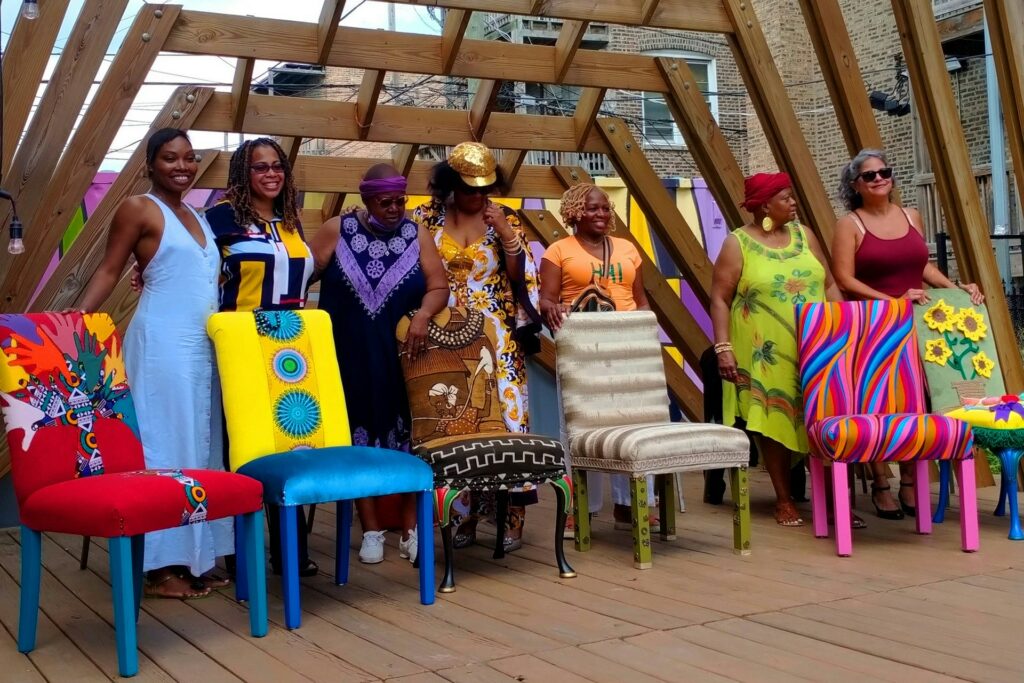
As Jamika and the other artists worked on chairs for Blooming Out of Trauma, they also processed their own personal histories. Jamika elaborates, “I learned more about my history through this project, especially the history that is not taught in schools or books. Even history that our ancestors or family members may have been uncomfortable or ashamed to tell. That history is hidden.” Continuing to reflect, Jamika stated that upholstery teaches: “First, to have patience to assess that there is trauma, and then second to identify and put a name to that trauma, and third, how do you compartmentalize or release that trauma; how do you put it in its proper place.” Through reflecting on personal histories and struggles, Blooming Out of Trauma seeks to allow a space for trauma to be processed.
The way Jamika approaches upholstery centers the experience of individuals and upholstery’s role in connecting groups of people through their experiences. Speaking to the collaborative nature of her work, she says, “It is so much better doing stuff with other people and not solo. You get to learn so much more about individuals’ personalities, passions, desires. When it comes to art, you also learn about their struggles and challenges when it comes to monetizing their art and how challenging it can be to connect their art to the mainstream.” For Jamika, upholstery is a reflective process: “Upholstery can be tedious work, especially since you work with your hands, so students tend to get frustrated through the process, just to come out of the process with a better understanding of who they are as individuals. If you’re impatient with this chair, where else are you impatient? Are you impatient with your health, finances, etc.” Through the process of upholstery, individuals come to a greater understanding of themselves, their history, and their community that can be shared through works of art.
Exploring Assets in the Latino Community: A Seat at the Table
Jamika has also partnered with the Illinois Legislative Latino Caucus Foundation, where she worked with 17 artists from community areas represented by members of the Illinois Legislative Latino Caucus to create chairs representing their community areas on a project called “A Seat at the Table.”. For this project, Jamika joined with Dr. Patricia Novick, a 2023 Goldin Global Fellow, who guided the artists through an Asset Based Community Development training, while Jamika hosted workshops walking the artists through the process of designing and creating a chair that tells the story of their district. Afterwards, the chairs were auctioned at the ILLCF’s annual gala, where $1 million was ultimately raised for their scholarship program.
Artists in the workshop came from multiple generations and represented multiple community areas, but came together to imagine ways in which their communities could be represented through chairs. Jamika emphasized the way the artists were able to join together as a community: “17 artists went into the workshop without really knowing each other that well. And it was an intergenerational group from 16 years old to 65. […] The idea was that even though they did not know each other, they all came into this one space as if they were family.“ Each artist was also allowed their own voice and aimed to capture something about their community. Jamika continued: “Each Chair had a foundation of community, but it was told in 17 different ways. That was the most powerful part about it: it was about community, building, and collaboration, but each one of them had their own separate voice in displaying what it meant for them.”

The artists who worked on a Seat at the Table aimed to showcase a variety of Latino experiences that depict a rich culture. Madison Cervantes, created a chair representing the first senate district and notes: “The butterflies I put on my chair represent all of the immigrants within the 1st district. I wanted to use different materials for their symbolic meaning. Latinos, we are everywhere and we know how to use many different materials and we venture out and I just wanted to represent that we are not linear people.” Silvia Morales created a chair for the 23rd congressional district that incorporates items from vendors in her community: “I wanted to include a lot of aspects of our community as hard workers, but also as people, people who need to rest.” Through reflecting on these chairs, both the artists and community members are asked not only to think of the Latino community, but also assets within that community that can be used to build strength.
This year, Jakima hopes to launch another project similar to A Seat at the Table and collaborate with organizations across Chicago. She imagines creating Peace Circles, identifying topics, and addressing current issues to guide upholstery workshops. As seen through both Blooming Out of Trauma and A Seat at the Table, these workshops would provide spaces for artists to work with their communities to explore their histories, identities, and assets.
Storytelling to Build Community: 2023 Peace Fellows Hold Speak Your Peace Workshop
Storytelling serves as an important medium for many Chicago Peace Fellows to raise awareness and promote solutions to problems that they face in their community. On October 21, the 2023 Chicago Peace Fellows hosted the Speak Your Peace workshop, dedicated to building power and community through inter-generational mixed-media storytelling. The event was held at the Chicago Center for Arts and Technology (CHICAT) on the West Side of Chicago. Peace Fellows on the Speak Your Peace team included: Nachelle Pugh, Antwan McHenry, Kanesha Walker Amaro, Carlil Pittman, Devonta Boston, Alexandra Auguste, Zahra Glenda Baker, Diane Deaderick DeMarta, Ceola Henderson-Bryant, and Lauryn Collins.
Speak Your Peace was one of a series of Summer Projects organized and hosted by the 2023 Chicago Peace Fellows to apply lessons learned through the GATHER curriculum to build peace within their communities. Peace Fellows participate in GATHER, an online asset-based community engagement course, as well as in-person training, collaborative action projects, and networking experiences with civic leaders, academic researchers, and policy makers throughout the year. These lessons culminate in a series of planning workshops where Peace Fellows can apply their newly learned skills and connections to a summer project that builds on the talents of their neighbors and the assets of their communities to make real and lasting change.

Throughout their fellowship, the 2023 Peace Fellows had a series of planning meetings where they set the scope of their Summer Projects: determining which beneficiaries to target, choosing potential community partners, and drafting a program. After determining projects and team members, the Peace Fellows met on their own to plan. “We were all sitting at the table and picking these projects, and our group felt it was really important for people to tell their story".
"In our community there are so many different things that go on, some of which are great and some of which are harmful and violent. We wanted to give people an opportunity to think about those things so that we can build on their experiences and make changes.”
- Nachelle Pugh

Centering Community Voices
The Speak Your Peace team sees storytelling as a way to show people from outside of their communities the challenges and triumphs of their neighborhoods. Nachelle elaborates, “Just looking [from outside] and trying to decipher what is going on is different from someone telling you what is going on. I think that’s what we were able to do with the storytelling at this event.” By providing a workshop and creative space for community members on the South and West side, Speak Your Peace aimed to center voices that are often ignored.
“To me it’s important to speak your peace, because if you don’t speak it, someone else will.”
- Kanesha Walker Amaro
By focusing on affirmative storytelling and highlighting the voices in the community, Speak Your Peace aimed to combat harmful narratives that are imposed from the outside.
Storytelling at the workshop showcased a variety of talents within the community with photography, art, poetry, music, and film working in unison to express a variety of voices. Hip hop artists, filmmakers, poets, and photographers from the community all had opportunities to present their talents. One of the featured artists was a filmmaker who started making films at the age of 17. At the event, the audience watched her documentary, filmed 7 years ago, which captures instances of police brutality that were spotlighted prior to the Black Lives Matter movement and shows the filmmaker’s view as an insider witnessing the violence. Another artist was a poet who used the space to share poems about her refusal to let any disabilities define her and allow her to center her experiences through poetry. The stories shared at Speak Your Peace were inter-generational and mixed-media, allowing for new connections to be generated between a range of communities.
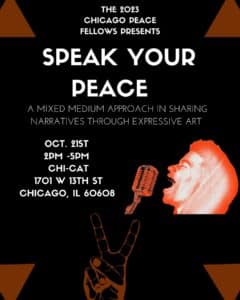
Mixed-Media Storytelling Build New Connections
Many of the Peace Fellows involved also had an opportunity to showcase their own artistic talents, which often do not have a chance to take center stage in their community work. For instance, Antwan McHenry curated a photography exhibit that showcased a variety of artists as well as his own work, which included a series of self-portraits he took during the height of the COVID-19 pandemic. Nachelle expressed admiration for his photographs, “Antwan, is an amazing photographer. […] Those pictures told a lot of stories of what was going on in his life, but probably also the lives of many others who were self-isolating. It was depression, it was confusion, it was chaos, it was sadness, it was the happiness at the end of the tunnel. All of those photos told the story of his experience.“ Kanesha, another 2023 Peace Fellow, also had the opportunity to share her poetry and bring in other local poets to perform.
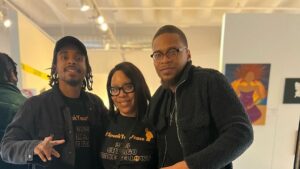
Speak Your Peace allowed for new connections to be made between artists and community activists across the South and West Sides. Reflecting on Speak Your Peace, Nachelle said that the most important thing accomplished was: “Building relationships with the community that was there."
"Working with the folks in our group, we got a chance to know each other, for real."
- Nachelle Pugh
We had been doing different workshops and activities, but we never really had a chance to [...] do the work that we do together and watch each other shine, and to be able to make suggestions with our personal experiences to help each other and make this event amazing. I think that’s the most important part and what I loved the most. Once we were done, everyone was like ‘yeah we gotta do this again and make it into something we do regularly’”. After the event, artists continued to connect and plan collaborations that will continue to center lived experiences for the world to experience and reflect on.
Visit to Haitian Art Museum of Chicago
First of its kind museum in the midwest celebrates the rich history of Haitian culture and the arts
We recently made a visit to the Haitian American Museum of Chicago (HAMOC) to coincide with their second anniversary. This was a significant milestone for Founder Elsie Hernandez, and also for the City of Chicago, as her plans for the museum dated back 12 years before finally being able to break ground in 2012.
The Museum is the first Haitian American Museum in the Midwest and was established to provide a space to promote Haitian history, culture and art. In particular, the Museum has partnered with the Haitian Creole Language Institute of New York to provide Creole language lessons.
The Museum is of particular significance to the Goldin Institute as we have partnered with organizations in Haiti to address the increase in violence against women following the earthquake in 2010. We look forward to supporting the Haitian American Museum as it grows and evolves into a premier cultural institution in Chicago!
[slide][img path="images/cesar_and_alejandro.jpg"]Museum Program Director Cesar Ramirez takes GI staffer Alejandro Di Prizio through the permanent collection on display at the HAMOC[/img] [img path="images/FullSizeRender.jpg"]Museum and Goldin Institute associates on the recent tour of the HAMOC.[/img] [img path="images/sculpture.jpg"]One of the many sculpture pieces on display at the HAMOC.[/img] [/slide]
